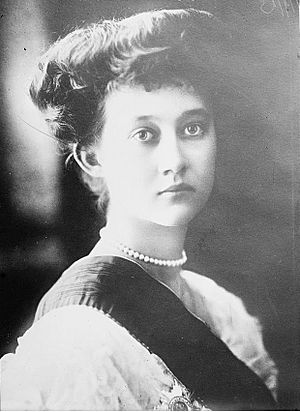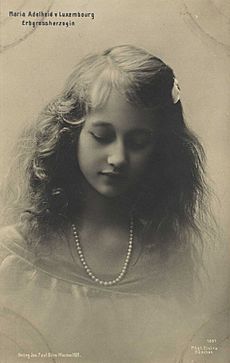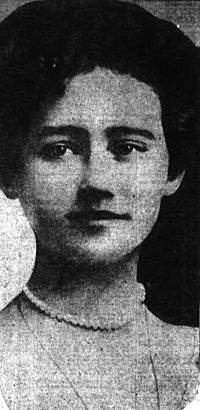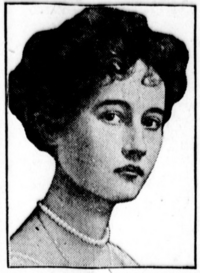Marie-Adélaïde, Grand Duchess of Luxembourg facts for kids
Quick facts for kids Marie-Adélaïde |
|||||
|---|---|---|---|---|---|

Marie-Adélaïde
|
|||||
| Grand Duchess of Luxembourg | |||||
| Reign | 25 February 1912 – 14 January 1919 |
||||
| Predecessor | William IV | ||||
| Successor | Charlotte | ||||
| Regent | Marie Anne of Portugal (1912) | ||||
| Prime Ministers |
See list
Mathias Mongenast
Hubert Loutsch Victor Thorn Léon Kauffman Émile Reuter |
||||
| Born | 14 June 1894 Berg Castle, Colmar-Berg, Luxembourg |
||||
| Died | 24 January 1924 (aged 29) Schloss Hohenburg, Lenggries, Bavaria, Germany |
||||
| Burial | Notre-Dame Cathedral, Luxembourg | ||||
|
|||||
| House | Nassau-Weilburg | ||||
| Father | William IV of Luxembourg | ||||
| Mother | Marie Anne of Portugal | ||||
| Religion | Catholicism | ||||
Marie-Adélaïde (born 14 June 1894 – died 24 January 1924) was the Grand Duchess of Luxembourg from 1912 to 1919. She was the first female ruler of Luxembourg in a very long time. She was also the first Luxembourgish monarch to be born in the country since the 1300s!
Marie-Adélaïde became Grand Duchess when she was just 17 years old. She ruled during World War I, a very difficult time. People in Luxembourg and other countries felt she was too friendly with the German forces who occupied Luxembourg. Because of this, she became very unpopular.
In 1919, under a lot of pressure from her people and the government, she decided to step down. This is called abdication. Her younger sister, Charlotte, took her place. Charlotte then helped save the monarchy in Luxembourg. After giving up her throne, Marie-Adélaïde lived quietly in a monastery in Italy. She passed away at the age of 29.
Contents
Early Life and Becoming Grand Duchess
Marie-Adélaïde was born on 14 June 1894 at Berg Castle in Luxembourg. She was the oldest child of Grand Duke William IV and his wife, Marie Anne of Portugal.
Her father, Grand Duke William IV, had six daughters but no sons. In Luxembourg, there was an old rule called Salic law. This law meant that only sons could inherit the throne. To avoid problems with who would rule next, her father changed the law in 1907. He named Marie-Adélaïde as the next in line to the throne. This made sure that a woman could become ruler if there were no sons.
When her father died on 25 February 1912, Marie-Adélaïde became Grand Duchess. She was only 17 years old. Her mother, Marie Anne, acted as regent (a temporary ruler) until Marie-Adélaïde turned 18. On her 18th birthday, she officially took her place as the first reigning Grand Duchess of Luxembourg.
Her Time as Ruler
Marie-Adélaïde was very interested in politics. She took an active part in the government of Luxembourg. At that time, the Grand Duchess had a lot of power according to the country's rules. She was a very religious person and had strong traditional views. For example, when she became ruler, she refused to sign a new law. This law would have reduced the role of priests in schools.
When World War I started in 1914, Luxembourg was a neutral country. This meant it was not supposed to take sides in the war. However, Germany invaded Luxembourg on 2 August 1914. Marie-Adélaïde and her government protested, but they could not stop the German army.
Luxembourg and its people did not fight back against the German occupation. They tried to stay neutral throughout the war. Marie-Adélaïde helped the Red Cross in Luxembourg. She even nursed soldiers. However, many people in Luxembourg and other countries saw her as being too friendly with Germany. She had received the German Kaiser (Emperor) at her palace. She also agreed to meet the German commander.
In 1915, Marie-Adélaïde caused some trouble. She dissolved the Chamber of Deputies, which is like Luxembourg's parliament. This meant new elections had to be held. While this was allowed by the rules, it was unusual. Many politicians, especially liberals and socialists, were upset. They felt it was like a coup d'état, which means taking power illegally.
After the war ended, Marie-Adélaïde was strongly criticized. The French government said they could not work with her because they felt she was too involved with the Germans. Even though she had not broken any laws, people in Luxembourg's parliament started asking her to step down.
On 9 January 1919, some politicians even tried to declare Luxembourg a republic, without a monarch. There was public unrest in the streets. Under a lot of pressure, Marie-Adélaïde decided to abdicate on 14 January 1919. She was only 24 years old. Her younger sister, Princess Charlotte, became the new Grand Duchess.
Prime Ministers During Her Reign
During Marie-Adélaïde's time as ruler, the following people served as Prime Minister:
- Paul Eyschen
- Mathias Mongenast
- Hubert Loutsch
- Victor Thorn
- Léon Kauffman
- Émile Reuter
Life After the Throne
After giving up her throne, Marie-Adélaïde traveled around Europe. In 1920, she joined a convent (a religious community for women) in Italy. She later joined another group of nuns in Rome, taking the name "Sister Marie of the Poor."
However, her health got worse, and she could not continue to be a nun. She then moved to a place called Schloss Hohenburg in Germany. She passed away there on 24 January 1924, at the age of 29. She died from the flu. Marie-Adélaïde never married or had children. Her body was later moved and buried in the Notre-Dame Cathedral in Luxembourg City in 1947.
Titles and Honours
- Titles
- 14 June 1894 – 10 July 1907: Her Grand Ducal Highness Princess Marie-Adélaïde of Luxembourg
- 10 July 1907 – 25 February 1912: Her Royal Highness The Hereditary Grand Duchess of Luxembourg
- 25 February 1912 – 14 January 1919: Her Royal Highness The Grand Duchess of Luxembourg
- 14 January 1919 – 24 January 1924: Her Royal Highness Grand Duchess Marie-Adelaide of Luxembourg later Sister Marie of the Poor
- National Honours
 Luxembourg: Grand Master of the Order of the Gold Lion of the House of Nassau
Luxembourg: Grand Master of the Order of the Gold Lion of the House of Nassau Luxembourg: Grand Master of the Order of Adolphe of Nassau
Luxembourg: Grand Master of the Order of Adolphe of Nassau Luxembourg: Grand Master of the Order of the Oak Crown
Luxembourg: Grand Master of the Order of the Oak Crown
See also
 In Spanish: María Adelaida de Luxemburgo para niños
In Spanish: María Adelaida de Luxemburgo para niños
- German occupation of Luxembourg in World War I




